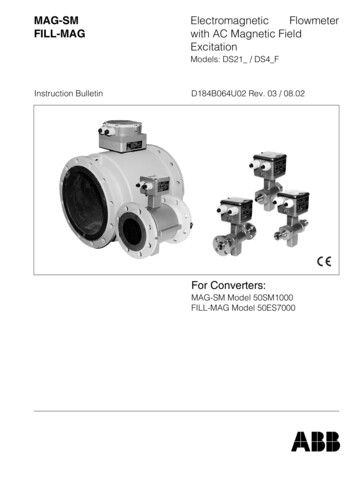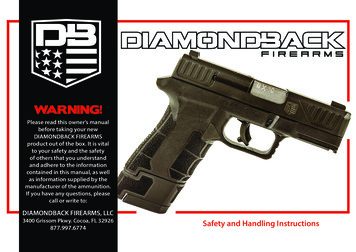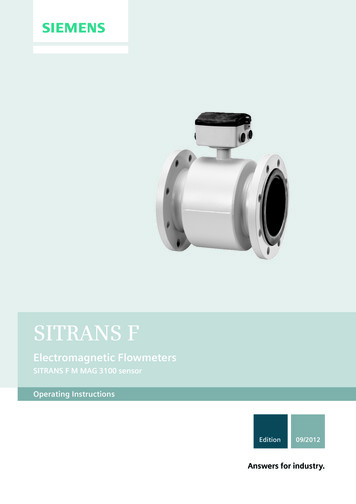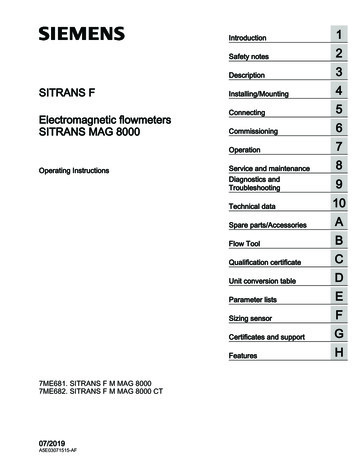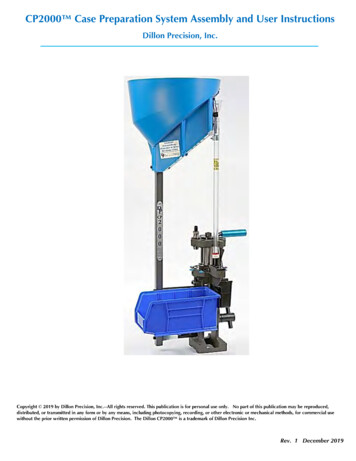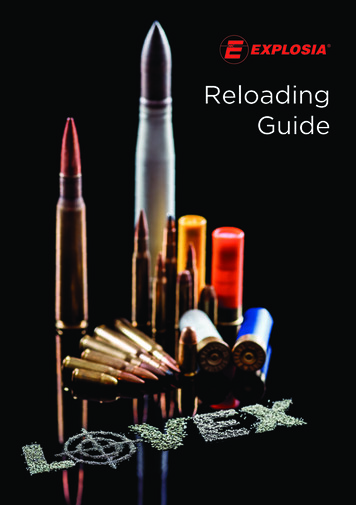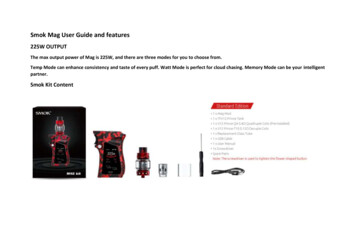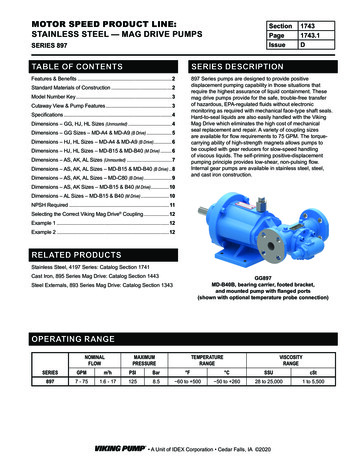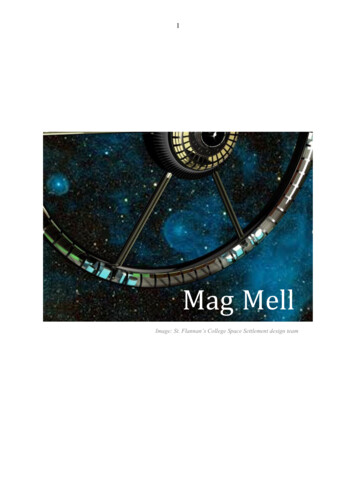
Transcription
1Mag MellImage: St. Flannan’s College Space Settlement design team
2ContentsExecutive Summary P31. Naming the settlement p42. Meet the Team p53. Structure of the settlement p64. Solar Power on the Settlement p145. The Gaseous Mond process p166. A Case Study of two Asteroids p187. S.H.E.P.H.E.R.D. p198. An Updated Design and a New Material for a Space Elevator Tether p219. Volume and Rim area of Mag Mell p2510. Placing our Space Settlement in High Orbit around Ceres p3111. Super-Powers for Space p3212. Ceres p3713. Agriculture and Food Production p3914. The Woven City p4215. The Commercial Opportunities for our Space Colony p4316. Zero Gravity American Football p4417. Bibliography p46
3Executive summary“Ideas have consequences and the worst idea we have ever had as a civilisation,is that we have access to limited resources. The correct thing to say, is that wehave access to limited resources on Earth . because the moment you lift yourgaze up from the surface of the Earth and out into space, to the asteroid beltand beyond, then, you see that there are effectively unlimited resources outthere”Prof. Brian Cox paraphrasing Dr. Robert Zubrin1For the occupants of our off-world space settlement to thrive, a supply of food, water and airis essential. By constructing and placing our rotating space settlement in the asteroid belt andin orbit around Ceres. The water and minerals required to grow food and make nitrogen richair on our settlement can be sourced form Ceres itself and from selected asteroids in theasteroid belt. Further, all the materials for fabricating our space settlement are at hand in thisregion of the solar system, as the asteroid belt is abundantly rich in mineral resources andchemical volatiles.We have an opportunity to make an off-world space habitat, that is a desirable and excitingplace, for up to 10,000 people to live, for children to be born and grow up, for scientificresearch to be carried out, for television and cinema films to be shot, for new industries,materials and space technologies to be developed, for people from Earth to visit and a placewhere for the sheer fun of it, zero-gravity can be experienced, and to assist industrialmanufacturing processes. Our Space Settlement will be people centred, incorporating thedesign concepts of Toyota’s ‘woven city’4. Mall Meg “will serve as a test site for newtechnologies4” and is an opportunity to create new possibilities for a collective future6.Given the fragility of human existence on our planet, we have an obligation to optimise thesurvival chances for our species and to develop space settlements in our solar system andultimately in other solar systems. The threats to our survival on Earth from asteroid impacts,nuclear weapons, anthropogenic global warming, and scarcity of resources compels us tospread out as a species, into the solar system. We must learn and adapt as a species to livingin new and challenging environments.
4Naming The SettlementWe have called our Settlement Mag Mell2. Mag Mell was a mythical land in Irish mythologyand translates from the Irish as a delightful or pleasant plain. Something akin to Elysium inGreek mythology. We want our Space Settlement to be a great place to live. Residents ofMag Mell should be able to enjoy a very good quality of life as per the United Nations humanDevelopment Index5. Health, Education, and Income will be prioritised.Stand Out Features of Our Space SettlementOur Space Settlement has been partly inspired by Dr. Pekka Janhunen’s paper 3“Interconnected and growable Ceres mega satellite world” (2021), the work of Jason Dunn ofMade in Space inc. and Toyota’s Smart City4 (called the Woven City). The woven city isintricately designed with autonomous technologies, smart homes, mobility, and roboticstechnologies being central to the functioning of the city. Our Space settlement will be constructed robotically in-situ, in high Ceres orbit(r 100,000 km, equatorial orbit) 3 using materials mined from Ceres and nearbytransported asteroidsA space elevator will be constructed on Ceres (elevator cable, 1024km in length) 3Ceres’ rotation period is 9.02 hoursOur Space Settlement structure will be 3-d printed in-situOur Space Settlement will be a rotating half-cut Torus with different angularrotation rates for the central hub and outer rimOur Space Settlement will have artificial 1g gravity and an Earth like atmosphereThe Central Hub is split into zero gravity and micro gravity areasWe will use asteroid/Ceres regolith for radiation shielding and to make soil toallow us to grow trees and shrubs as we landscape our Space SettlementThe central hub of the settlement will contain our industrial and docking areasResidential areas will be constructed on the 1g outer rim at the termination ofeach spokeEach of the six residential areas (villages) will have different layouts and designsWe will begin controlled research of genetic modifications, to allow humans tocope better with space radiationOur Space Settlement will be a test site for new technologies, “A livinglaboratory”4The state of health of each resident will be monitored continuously via smartbody sensorsOur Space Settlement will contain its own film studioEase of mobility around our Space Settlement has been prioritised 4
5Meet the teamCian Pyne I am a 5th year student attending St Flannan's College. I amcaptivated by all things related to Space. I'm fascinated by sci-fi films and theidea of humans travelling beyond Earth. I find great enjoyment in physics as ithelps me to understand the science behind ideas I come across in everyday life.My hobbies include basketball and swimming, and I would love to experiencespace travel one day.Jack O’ConnorI like playing rugby and Gaelic football. I spend my free time listening to musicand playing the guitar/ banjo. I like watching videos about interstellar spaceand I think physics helps me to imagine a future interplanetary species and alsounderstand phenomena in everyday life.Adam DownesI am a 5th year student in St Flannan’s College Co. Clare. My hobbies areplaying sport and music (piano). I enjoy physics and maths and hope to be anengineer.I’m Garbhán Monahan from Ennis, Co Clare and I study physics in school.Ever since I was young, I always found the laws and theories of physicsfascinating, especially the ones about space. I also love music, reading andTeakwon-Do.Naem HaqI am a 5th year student in St. Flannan's College, Ennis, Co. Clare. My hobbiesinclude soccer, badminton and reading astronomy discoveries. I am interestedin Medical Sciences and Space related developments. I am extremelyenthusiastic about Physics and maths, and I love problem solving especiallywith my classmates.
6Structure of the SettlementBasic Shape and Dimensions of Mag MellA half-cut rotating torus with six spokes and a central hub that can rotate at a different rateof rotation to the outer rimImage: St. Flannan’s College Space Settlementdesign teamHalf-Cut Rotating Torus.With Six Spokes and innercentral hub400R200220000
7The Outer ShellUltra-pure iron nickel steel will provide the material for the internal frame and outer ‘skin’ ofthe settlement. The outer shell of the station will be approximately 2m thick and will beformed from a honeycomb framework of iron nickel steel.The settlement will be 3d printed in high Ceres orbit. Iron nickel ore will be sourced fromnearby metallic asteroids. Asteroids will be transported to Ceres High orbit and processedthere using the gaseous ‘Mond process’. The space settlement will be 3-d printed in sections,using the ultra-pure iron nickel (from the Mond Process) as the feedstock, and the sectionswill be assembled and welded togetherGround up silicates from asteroids will provide radiation shielding, the silicates will beincorporated between shell layers and into the honeycomb reinforcing structure. Floors willbe made of a similar iron-nickel steel honeycomb structure iron and will be up to 1m thick,interior walls will be 0 .5m thick.Image: St. Flannan’sCollege Space Settlementdesign teamEmpire State building(Size comparison of Mag Mell with theEmpire State building (436m)Space Settlement(2200m diameter)WindowsThe windows of the torus are designed to maximise the amount of light that can enter thetorus. They also allow the residents to get an unobstructed view of Ceres and beyond.The glass in the windows will be constructed from aluminium oxynitride7 otherwise known astransparent aluminium.Shutters can be operated to create an artificial night inside the settlement and to protect thesettlement from the impacts of larger objects.Image: St. Flannan’s College Space Settlementdesign teamWindows ‘artificial night’ or protection modeWindows ‘artificial day’
8Torus DimensionsThe torus is a half-cut rotatingtorus with a radius R 1100 mand a minor radius, r 200 m. Asit is a truncated torus the “floor”relative to the inhabitants will be2 times (r) or 400m across whilethe ceiling will be 200m high.The Villages, their Transport Stations and HighwaysThere will be six residential areas/villages surrounding each lift transport station. The layoutof the villages will allow a sense of local community to develop. The villages will havemixed residential and commercial development.The village transport stations contain elevators which link to the central hub. They are alsoconnected to the rim’s transport/mobility network.The transport station with office and residential areas Image: St. Flannan’sLiftSpacesystemSettlementtransport stationCollegedesign teamAs in Toyota’s ‘Woven City’4, there will be three different types of mobility highway, eachtype catering for a different form of mobility. The first type is a highway for fastertransportation, and it is tree lined to mark off its boundaries. Vehicles using this highway willbe autonomous and electric6.The first type is for faster transportation (electric cars). Image credit: Screenshot-1,Toyota Motor Corporation presentation6, CES Las Vegas, 6th Jan 2020, [3mins,21sec]
9The second type of highway/street will be an urban street promenade6 (for the towns) sharedby pedestrians and slower personal mobility vehicles, for example electric scooters. Thestreet promenades will be landscaped to make them more interesting looking and natural.The Urban Street Promenade. Image Credit: Screenshot-2, Toyota Motor Corporation presentation6,CES Las Vegas, 6th Jan 2020, [3mins,27sec]The third type of street will be a linear park.6 With lush green areas, extensive planting oftrees and shrubs and continuous paths for pedestrians only.The Linear Park. Image Credit: Toyota’s Woven City6: Screenshot-3, Toyota Motor Corporation presentation6,CES Las Vegas, 6th Jan 2020, [3mins,35sec]The VillagesThe residents of the torus will reside in smart technology apartment blocks. The apartmentblocks will be similar in style to those on Earth, these apartment blocks could be 40m highwith up to 13 storeys. Each person needs a minimum of 25m2 (according to the Tokyo, Japanbuilding regulations8) A very basic calculation allowing for 600m2 per storey habitable floorarea, gives a living space for up to 310 people per block and so 33 of these apartment blockscould accommodate 10,000 people.
10The Six Spokes and their ElevatorsThe spokes serve multiple purposes. These include linking the torus to the central hub andproviding transport to the central hub and back to the torus via high-speed elevators.Cross-section of ElevatorsThe SpokesThe outer shells of the spokes have structural strength, so they can withstand the forcesgenerated as the torus rotates and to protection the elevators against meteoroid impacts.There are nine elevators contained within each ‘Spoke’, for transport between the rim andcentral hub. One large cargo elevator 30m in diameter (see above diagram) and eight smallerpeople carrying elevators.People and Cargo elevators at the transport stationImage: St. Flannan’s College Space Settlement design team
11The Agricultural AreaThe multi-level Agri-Areas (farms) are suspended from the ceiling, this maximises the use ofspace within the torus. They will utilize both natural sunlight and led lighting. These farmshave an area of 47420m2 per level. With 6 levels per farm and a total of six farms (see imagebelow) that leaves us with a total area of 1,707,120 m2. Plants will be grown in these farms inhydroponics bays. This will enable us to maximise our food our food production.The suspended farmsImage: St. Flannan’s College SpaceSettlement design teamThe Central HubThe central hub performs many functions, heavy manufacturing, space craft docking and aplace for leisure and sports amenities.We have split the central hub into two parts. The outer section (outer hub) will remainconnected to the spokes and rim of the station and so rotate at the same angular rate as theouter rim. It has multiple floors (layers). The effective value of gravity for the floors in theouter rim, will be lower than at outer rim of the torus, as their distance from the axis ofrotation is lower than at the rim. The inner section of the hub will be capable of rotating at adifferent rate to the outer rim, thanks to the transfer ring and magnetic bearings.Image: St. Flannan’s CollegeSpace Settlement design teamCentral hub with locking ring
12As mentioned above the outer hub (with four floors) rotates at the same rate as the spokes andouter rim. The outer hub values of gravity range from 0.2g to 0.1g (a rω2 and r, ranges from110m to 200m, 𝑎𝑛𝑑 ω 0.0994436 rad/s ) This section for the lighter manufacturingindustries. The heavy industries will be in the gravity free, non-rotating section of the centralhub. The outer hub is divided into multiple floors each with progressively less gravity. Eachfloor will contain factories and other industrial plants which could range from electronicdevice production to chemical manufacturing.Inner hubImages: St. Flannan’s College SpaceSettlement design teamCross section of the outer and inner hubs with transfer ring. Note the fourfloors on the outer hub, with floor radii, to central axis, ranging from,110m to 200m. The inner dome is the zero-gravity zone as it doesn’trotate. The outer hub values of gravity range from 0.2g to 0.1gMany of the settlement inhabitants will work here. However due to the reduced gravityenvironment in the central hub, there will be a limit to the daily time period they can spendhere, due to muscle and bone degradation caused by low gravity environments.Central HubImage: St. Flannan’s College Space Settlementdesign teamAs the inner hubexperiences zero gravity itis the perfect location forheavy industries and otherzero g activities. The innerhub houses a large,pressurised area.Space Craft repairs andindustrial activities whichcan benefit from a zerogravity environment, can becarried out here. A greatplace to experience Zerogravity!
13The Transfer RingFreedom of movement will be achieved using electromagnetic bearings which will both allowthe inner hub to rotate relative to the space station and allow precise control of the rotationalspeed through precise adjustments to the magnetic fields created by the bearings.Due to the inner and outer hub sections rotating relative to each other, we have introduced anintermediate third pressurised section. This section can speed up and slow down to match therotational speed of either hub section. The transfer ring as it is named can then lock on to thechosen hub section and airlock with it. This allows cargo and people to move from the hubsection to the transfer ring and back. The ring then disconnects from the hub section and usesits electromagnets to match the speed of the other hub section with which it airlocks. In thisfashion people and cargo can move between the two hub sections, while staying safely in apressurised environment.Transfer RingImage: St. Flannan’s College SpaceSettlement design teamFor a person to travel from the stationary section to the rest of the station they would have tomake their way to one of the airlocks for the transfer rings. They would then wait for thetransferring to match the rotation of the stationary hub and the airlocks with engage. Theywould then move into the transfer ring, which would then disengage and speed up to therotational speed of the rest of the station. The other set of airlocks will then engage, andpeople can then make their way out and into the rest of the station.The transfer rings will constantly be moving from the stationary hub to the rotating stationand back at set intervals allowing the inhabitants to plan their journey.
14Solar Power on the Settlement9Image below: Team DrawingAssuming 1390W/m2 solar power at 1AuCeres at 2.8Au, gives 1390/(2.8)2 W/m2(Inverse square law for light intensity)So, 77.3 W/m2 of Solar power, is available atCeres high orbit.Allowing a max of 18KW per person9, as on the I.S.SInternational Space Station and taking 22%as the efficiency of the solar cell.77.3W/m2 @ 22%, efficiency gives 38.98W/m2for the solar array (Right Image).Hence, 18000W requires (18,000/38.98) m2or 461.8 m2, that is 461.8 m2 per person.Hence 10,000 people need 4617753 m2of solar array area, or (2148m)2There will also be some visible light from a mirror angled at 45o above the settlement (seediagram above). Similar in the design of the mirror in the original Stanford Torus.Cooling requirementsUsing the figures from ‘Powering the Stanford Torus’ by Nikolas Martelo9 (2017), weestimate that, as our settlement is very similar in design to the original Stanford torus, it willrequire an area of 1199025 m2 or (1095m)2, for the habitat radiator. The coolant will beammonia based. We have some cooling fins at the low gravity section of the central hub.
15Additional view of Space SettlementView of settlementImage: St. Flannan’s College Space Settlement design team
16The Gaseous Mond process, to produce ultra-pure iron and nickel metalfor the 3-d printing of our space settlementIn their paper ‘BENEFICIATION OF ASTEROIDAL MATERIALS IN SPACE’ (2012),Richard M. Westfall and William C. Jenkin, outline how stony/iron and iron asteroids can bemined for their metals19. The material from the asteroids or meteoroids is pulverised into a powderFor stony/iron powder, metals are separated using magnets (not necessary for theiron asteroid)Expose to carbon monoxide gas at 100 atm. pressure and a temperature of 120 0Cthe iron and nickel iron pentacarbonyl gas and nickel tetracarbonyl gas 12These metal carbonyls are highly toxic 18 (the carbonyl process is better suited tospace than Earth for this reason)The nickel and iron carbonyl can be separated by fractional distillationThe carbonyl gases can be turned into their metals by exposing them to a heatedsurface, Chemical Vapour Deposition (CVD)The Chemistry of the Mond processThe gaseous ‘Mond Process’14 (named after Ludwig Mond) is the method used to producemost of the world’s nickel and cobalt from their ores12, it has been in commercial use since1905. If you were to separate the metal from a stony/iron or iron asteroid, and expose it tocarbon monoxide gas at 100 atmospheres pressure, and a temperature of 120 0C, the iron andnickel form iron pentacarbonyl gas and nickel tetracarbonyl gas12Fe (S) 5CO(g) Fe(CO)5 (g) Iron pentacarbonyl gasNi (s) 4CO(g) Ni(CO)4 (g) Nickel tetracarbonyl gasThese carbonyl gases have a similar freezing and boiling point to water and a similar vaporpressure; However, their vapour pressures are sufficiently different from each other to allowthem to be separated by fractional distillation. As these carbonyl gases have similar boilingand melting points to water, they are liquid at room temperature, allowing them to be pouredinto molds. Heating the metal carbonyl in the mold to 200 0C decomposes it and carbonmonoxide gas (CO) is released, leaving behind ultra-pure iron or nickel.Other CarbonylsCarbon monoxide gas can similarly be applied to produce carbonyls of chromium, osmium,ruthenium, iridium, rhenium, cobalt and tungsten. Again, these can be decomposed into theirmetals. These metals can be combined with iron, to form various types of ultra-pure steel.Generally meteoric iron contains up to 30% nickel, up to 1% cobalt and platinum groupconcentration up to ten times better than terrestrial iron ore (the platinum group metals tendto occur together12).
17Iron CarbonylThe iron carbonyl can be made with extremely high purity12. After thermal decompositionanalytic grade iron is produced with a purity of 99.999999 % thus ‘six nines iron’. It can alsobe referred to as ‘high pure iron’ or ‘high purity iron’3. If you make this ‘six nines iron’ into awire its tensile strength is five times greater than piano wire. If you make a bracket or fixtureor a bolt from ‘six nines iron’, and put it into a terrestrial environment, it is so pure that it hasthe corrosion resistance of the best stainless steel. In short it is a superb structural material5.The Mond process would produce a much purer grade of metal than the melting in a furnaceof a ferrous metal asteroid. Smelting would produce a grade of metal containing many moreimpurities. Importantly the pure iron and nickel could be mixed to form nickel-steel alloy.The pure iron and nickel produced by the ‘Mond Process’ will be used as feedstock for our3d printer.Demandite17We are using the concept of ‘demandite’ to help us understand the scale of the resourcescontained in asteroids. ‘Demandite’ is a term used to provide a unit average of the materialsrequired for a person’s lifetime, in this case in space. Applying this idea to asteroids allows usto extrapolate from, the amounts of all the resources they contain, the number of people theycould possibly sustain. One unit of demandite includes all the materials needed forrespiration, agriculture, build of Space Settlements etc. The asteroid belt contains 8 1018‘demandite’ units. Enough to support a population of 10 million billion people from nowuntil the sun dies17 . This means that it could sustain a population one million times that ofEarth, over the same period.Resources Contained in Asteroids11Asteroid TypeC, P and DResources10% - 20 % waterExtinct cometMChondritesUp to 60% water iceUp to 99% ferrous metalsUp to 5%-30% ferrousmetalsExtraction method / UseExtraction: Vaporisation & MeltingUse: Propellent, life support material &Space agricultureExtraction: Solar powered furnaces, The‘Mond’ processUse: Making Space Settlement, Space Craftetc.Asteroids could be brought to high Ceres orbit for processing, SHEPHERDwould work well for asteroids which are loosely packed
18A Case Study of two Asteroids15To give some idea of the scale of the resources contained in asteroids, we will look at twoasteroids.Case study oneThe first named ‘1986 DA’ is a small M-type (metallic) asteroid. It is 3.1 km in diameter. Itis estimated that it contains 4 1010 tonnes of iron, not to mention over one million tonnes ofplatinum group metals, including 100,000 tonnes of platinum and 10,000 tonnes of gold.Professor John S. Lewis (University of Arizona) estimates that the total mass of the metalscontained in asteroid ‘1986 DA’ amounts to forty times the mass of all the metals mined overhuman history3.Case study twoIn John S. Lewis’ book ‘Space Resources15’ he considers a small ‘run of the mill’ S-type(stony) asteroid, one kilometre in diameter and two billion tonnes mass. The asteroidcontains 200 million tonnes of iron, 30 million tonnes of nickel, 1.5 million tonnes of cobaltand 7,500 tonnes of platinum group metals.2822Image: TheWillamette MeteoriteCapturing and ProcessingAsteroidsS.H.E.P.H.E.R.D.
19S.H.E.P.H.E.R.D.21Secure Handling by Encapsulation of a Planetesimal Heading to Earth-moon Retrogradeorbit DeliveryAs a team we were inspired by Dr. Bruce Damer’s TED SantaCruz Talk16 on how toretrieve an asteroid. This concept is a modification of the previously proposed ARM25(NASA’s Asteroid Redirect Mission) for capturing an asteroid.Many asteroids are likely ‘loose agglomerations of rocks and regolith’21. These asteroids,which are basically piles of rubble need to be handled with care as drilling or sawing throughthem will cause them to disintegrate. Dr. Damer proposes to solve this problem by capturingthe asteroid in a gas filled enclosure. The SHEPHERD method for capturing and transportingintact a weakly consolidated asteroid, complements project RAMA26.Image: courtesy of Dr Bruce DamerAs the robotic space craft approaches an asteroid (the asteroid will be spinning), it scans itwith its LIDAR (laser light is bounced off the asteroid producing a 3d image of it). Theballoon structure of SHEPHERD opens and encloses around the asteroid and seals it from thevacuum of space. Xenon gas at 0.1 atmospheres pressure is introduced into the enclosure.The gas slows down (force of friction) the tumbling asteroid until it stops.Image: courtesy of Dr Bruce Damer’s slides
20Waves of gas are now sent towards the captured asteroid, which is still sealed in the balloonand gas envelope . By Newton’s third law of motion that for every action there is an equaland opposite reaction. The space craft moves in the opposite direction to the wave of gasincident on the asteroid. A propelling force of 1.5 N will be generated by the gas waveinteraction, giving a delta-v of 100 ms-1 to the craft. This method could be used to captureweakly consolidated asteroids in the asteroid belt and move them to High Ceres Orbit forprocessing.The initial proposal for SHEPHERD is for the capture of asteroids ranging in size from100 tonnes to 1000 tonnes, it is also scalable. Having an asteroid enclosed in an envelopemeans that some processing of the asteroid can take place. Water can be boiled/fractioned offfrom an asteroid by heating its interior. This water could be stored in tanks attached toSHEPHERD. A nickel-iron asteroid could be further processed elsewhere using the ‘Mond’process (mentioned earlier), carbon monoxide gas driven through the partially separatedmetallic asteroid producing ultra-pure nickel and ‘six-nines iron’. These metals can be furtherprocessed downstream to produce a metal feedstock for our 3D printer.A nickel-iron asteroid being processed in carbon monoxide gas Image: Dr Bruce Damer’s, TED SantaCruzTalk16. Screenshot-[6mins, 01 secs]SHEPHERD will open a range of possibilities for space exploration. Icy objects existbeyond the solar system’s snow line, these could be captured processed and brought toanywhere in the solar system. Water and other volatiles (note; H2O can be electrolysed toproduce H2 and O2) could be placed at various points in the solar system. Water and volatileswill likely be a valuable commodity in space.“SHEPHERD” capturing and processing an object in outer solar system Images: Dr Bruce Damer’sTED SantaCruz16Screenshots [7.00mins](Left image) and [7mins 08 Secs](Right Image)
21An Updated Design and a New Material for a Space Elevator TetherOur design for a space elevator is based on Dr Bradley C Edwards’ inspirational 2003NASA Institute for Advanced concepts Phase II Final report. We have also incorporated thelatest space elevator thinking from the International Space Elevator Consortium (ISEC).In Dr Edwards’ 2003 conceptualised space elevator design, carbon nanotubes were used forthe tether, but Single-Crystal Graphene has emerged as a major new contender for a tethermaterial. This material Single-Crystal Graphene (‘Nixene’) meets the physical tetherproperties target, as determined in the ISEC and IAA (International Academy of Aeronautics)feasibility report on space elevators30(2013).Images: With kind permission of Nixene LtdWhat is single crystal graphene ? We will first look at graphene. This material was firstisolated in 2004 from graphite (material in a pencil). It is a 2-d ‘super’ material (it is oneatom thick) and layers of graphene attach to each other by Van der Waals forces to formgraphite.Image (a) graphene (b) graphite, layers of graphene held together by Van der Waals -graphene-present-andfuture-trends23
22Non single crystal CVD (chemical vapour deposition) graphene can be made using theprocess below23. ‘Copper oxide at the surface of the copper foil is reduced after annealing at1000oC in a H2 gas environment, the exposed Cu, copper develops grains on its surface. TheCu foil is then exposed to CH4 and H2 atmosphere at 1000 oC. The grains formed on thesurface of the copper, cause imperfections to arise in the graphene so it is not a lications-of-graphene-present-andfuture-trendsTo date Single crystal graphene has been made in small amounts, initially in Peking27( X. Xu et al, 2017). However, 1000 km long graphene sheets (one metre wide) are required toproduce a space elevator tether. How do we modify this process to produce single crystalgraphene? -A proposal for a method to produce km long sheets of this one atom thickgraphene material has been made by a Manchester, UK based chemist Adrian Nixon and hiscompany Nixene Ltd.Nixene Ltd, who are based in the Graphene Innovation Centre in Manchester (GEIC)propose using a fast process method to produce graphene without grain boundaries (singlecrystal). This new process concept which is currently under development is outlined in thediagram below.Graphene: A new continuous process. Image: With kind permission of Nixene Ltd
23The single sheets of graphene will be layered to form a super strong synthetic version ofgraphite called ‘Nixene’. It is proposed that the elevator tether could be constructed from‘ Nixene’.Image: multi layered single sheets of graphene forming ‘artificial graphite’, ‘Nixene’ Nixene LtdThe deployment of a space elevator cable begins with the launching, by conventionalrockets, of a space craft (in modular f
Mag Mell was a mythical land in Irish mythology and translates from the Irish as a delightful or pleasant plain. Something akin to Elysium in Greek mythology. We want our Space Settlement to be a great place to live. Residents of Mag Mell should be able to enjoy a very good quality of life as per the United Nations human Development Index5 .
